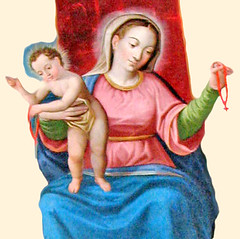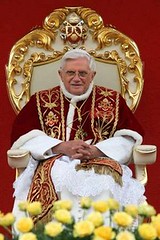Father of the Poor...
 "Let us all venerate Raymond's holy deeds which are resounding in the whole world; and let our choir with melodious song repeat his praises"! So sings the Office hymn, 'Sacra Raymundi veneremur omnes'.
"Let us all venerate Raymond's holy deeds which are resounding in the whole world; and let our choir with melodious song repeat his praises"! So sings the Office hymn, 'Sacra Raymundi veneremur omnes'.For on this day, Holy Mother Church and the Order of Friars Preachers give thanks to God for the gift of St Raymond Penyafort (1175-1275), who was the third Master General of the Order, taking office at Pentecost, 1238 after the sudden and tragic death by drowning of Bl Jordan of Saxony.
St Raymond was born of noble and perhaps even royal blood in the castle of Penyafort, near Barcelona. His parents were descendents of the Counts of Barcelona and related to the royal house of Aragon. Very little is known of his childhood apart from the fact that he received a good and pious education, worthy of his noble rank; he was sent to the cathedral school in Barcelona. He was a brilliant student and by the age of twenty, began teaching in Barcelona at the university. He had an aptitude for canon law and there is evidence that in 1204 he submitted an excellent decision to the bishop of Barcelona in the matter of a dispute between two canons. Around 1310, it was evident that his legal talents would be best served by further study in the renown University of Bologna.
In Bologna, St Raymond devoted his time to prayer and study and to works of charity to the poor. It was also in this city that he encountered the Dominicans and was enthused by Br Reginald of Orleans, then Prior of Bologna and a great preacher who attracted many Dominican vocations. After six years of study, he was awarded a doctorate in civil and ecclesiastical law and then invited to take up a professorship in the university. His lectures drew large crowds and they were free to all. The Senate of Bologna, learning of his generosity, voted to pay a large sum to annually. The saint accepted this but only in order to increase his alms-giving to the poor of the city. He remained in Bologna until 1219 when the bishop of Barcelona visited the city and asked St Dominic to send friars to Barcelona to found a Priory. Our Holy Father, St Dominic, agreed to this request and the Convent of St Catherine the Martyr was duly established in Barcelona, which stood until 1835 when it was sadly destroyed by revolutionaries. However, the bishop had another task - to induce Raymond back to his homeland. It is said that the bishop's request was supported by a letter from Pope Honorius III, telling Raymond to return to Aragon and educate their young king, James I. In any case, by now St Raymond's learning and legal acumen had gained the attention of the Holy Father.
Upon his return to Barcelona, Raymond was made a canon and archdeacon of the cathedral of Barcelona. He lived a life of examplary observance and piety, giving bountifully to the poor who called upon him. He also showed a tender devotion to Our Lady and devoted his time, money and influence to securing from the bishop a more solemn celebration of the Feast of the Annunciation and he spread this throughout the kingdoms of Aragon and Castille. This piety, his modesty, humility and generosity attracted the admiration of many and he was influential in reforming the cathedral chapter.
However he was drawn still to the Dominicans, remembering the fine example and preaching of Br Reginald back in Bologna. Thus, he joined the Order of Preachers in Barcelona, taking the white habit of our Holy Father St Dominic on Good Friday, 1 April 1222 and at the age of forty-seven, became a novice. In the words of the Office hymn, 'Pulchra, quae mundus peritura pandit': "Bravely spurning the perishable glories which the world displays, and longing for heaven. Raymond joyfully entered the cloisters of the Preachers..."
Just as in his life as a canon, he was exemplary in his observance and spent his spare moments in prayer before the Blessed Sacrament. He was also renown for his mortification, taking just one meal a day except on Sundays and went to confession daily before saying Mass. He was requested by the Provincial to compile a collection of cases of conscience for the guidance of confessors. This was to become the 'Summa de Casibus Penitentiae', the first work of its kind in which he collected all kinds of difficult cases and solved them by the authority of the Scriptures, Canon Law or the writings of the Fathers and papal decrees. Later in his life, he was commissioned by Pope Gergory IX to compile the Decretals of Canon Law and together with his Summa, these works were to become standard works and classics for canonists for the next 700 years! Thus the Office hymn, 'Grande Raymundi' immortalizes his work: "A learned man, he gathered with remarkable skill the scattered records of the supreme fathers: whatever sacred decretals of the ancient law were worthy of preservation..."
In 1223, together with St Peter Nolasco, Raymond founded the Order of Our Lady of Mercy for the Redemption of Captives. This new Order, confirmed by the pope in 1235, was founded to deliver and aid those pitiful Christians who had been captured as slaves by the Moors who terrorised southern Spain and northern Africa. Raymond preached for the abolition of slavery and he compiled the Order's rule based on the Rule of St Augustine and the Dominican Constitutions. Under Raymond's influence, king James of Spain supported the Order and gave a monastery to it.
In 1229, Pope Gregory IX sent a legate to Spain to preach a crusade against the Moors. The papal legate enlisted the aid of St Raymond who preached fervently to huge crowds that the Muslims would only be converted if the Christian people first conquered their own sinful passions and vices and purged themselves of envy, discord and hatred. The force of his preaching and example soon produced a general reformation in the morals of the populace and St Raymond spent hours in the confessional after preaching strenuously to the people. He so impressed the papal legate that on 20 November 1229 he was summoned to Rome.

Pope Gregory made Raymond his own confessor and Grand Penitentiary of the Roman Church. In this capacity, he dispensed justice and mercy on behalf of the Roman Pontiff and he was especially attentive to the needs of the poor. He expedited all matters relating to the poor, asking the pope to graciously hear the just pleas of those who were without protection and to act promptly upon the affairs of widows and orphans. This earned him the title, 'Father of the Poor'. During his time in Rome, St Dominic was canonized in 1234 and it was St Raymond who sent a communication at once to Bl Jordan of Saxony, then Master of the Order. Around this time, the pope appointed St Raymond as Archbishop of Tarragona but the saint begged to be released from this. Indeed, it was quite common for the early Dominicans to refuse episcopal office as it entailed administrative duties and such obligations - political and otherwise - which would take them away from their vocation as mendicants and itinerant preachers. It was obvious that Raymond's duties in Rome weighed heavily upon him and ruined his health so in 1235, the pope released him from service and he returned to Barcelona and to a quieter life as a confessor.
Therefore, when he was elected unanimously as Master of the Order in 1238, this rather shocked and surprised him; he accepted the office as a penance, submitting to the will of God. His chief work as Master General was to publish a new edition of the Constitutions of the Order, in a form which remains to this day. It has often been said that the Constitutions of the Order were to influence many later democratic Constitutions in Europe. In 1240, he resigned the Generalship, citing his age (then 65) and his infirmities. This is a reasonable request as the Master in those days would have had to travel by foot the length and breadth of Europe to the annual General Chapters!
But the indefatigable saint did not retire even after his resignation as Master. He now launched several projects intended to save souls and preserve the integrity of the Faith in Christian Spain and to preach the Truth of the Faith to the Muslims, Jews and others. At his suggestion, the kings of Aragon and Castille founded two monasteries with colleges attached to them, for the study of Hebrew and Arabic and the Quran. Truly he is a saint much needed in our time, to preach the Faith to the Muslims who assail the Church. It is believed that St Raymond also requested that St Thomas Aquinas write his 'Summa Contra Gentiles' which was completed in 1263 and used by the friars who ministered to the Jews and Muslims in Spain. It is believed that these efforts by St Raymond converted tens of thousands to the Truth of Jesus Christ.
At this time, St Raymond accompanied king James I of Spain to Majorca, with the intention of preaching to the Muslims there. However the king had taken with him his mistress and his immoral acts of lust caused St Raymond to rebuke the king of Aragon. When he saw that his remonstrances were ineffectual, he told the king he could not stay on the island with him as this would make it seem that he condoned the king's actions. But when he went to the docks, he found no vessel willing to let him board as the sailors feared the king's wrath. As such, Raymond said to his Dominican companion, "You will see that the King of Heaven will confound the wickedness of this earthly kinng and provide me with a ship." Having spoken thus, he went to the seashore, took off his cappa, or black cloak, and part of it on the water, while he fastened the other part to his travelling staff, like a sail to a miniature mast. Then he fearlessly knelt down on that part which floated on the water but his companion declined to do so. Making the sign of the cross, the saint then pushed off from land and quickly sailed away on his cappa. He made the journey of one hundred and eighty miles in just six hours and on reaching shore, he was cheered by the crowds who had seen him coming. He gathered his cappa and put it back around his shoulders and it was as dry as ever. This miracle, which is illustrated here, brought king James to his senses and he repented of his sins. A tower and chapel stands on the site of this miracle, on the spot where he landed and the incident is also told in song. The Office hymn in the Dominican breviary, 'Grande Raymundi celebrate nomen' says: "Embarking on the open course, the doctor proceeds to make solid the treacherous deep; making a boat from his mantle and staff, he crossed the sea..."
As he neared the end of his life, the royal families of Castille and Aragon came to his deathbed, seeking his blessing. Finally, fortified by the sacraments, Raymond died peacefully on the feast of the Epiphany in 1275. His funeral was attended by royalty and prelates and he was buried in the Priory in Barcelona where his tomb became a popular pilgrimage site. He was canonized by Pope Clement VIII in 1601 and is patron of canonists and lawyers.
But let us end with the prayers that adorn the Office hymns found on this day in the Dominican breviary: "O God, grant us morals without stain; give our life a safe journey without misfortune; grant us to reach the port of life that is enduring without end... Humbly we pray that the Ruler, One and Three without end, may grant us to follow the deeds of him whose noted triumphs we sing." Amen.
The stained glass image above is from St Dominic's church in Washington D.C.







0 Comments:
Post a Comment
<< Home